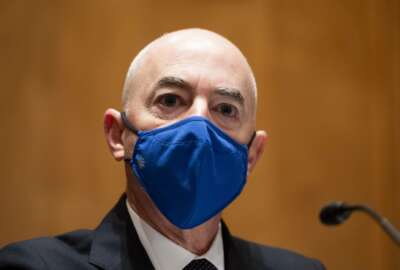
An update on a CDC program to improve the total health of people
The words workplace and worker health have taken on whole new meanings in the year plus long pandemic.
Best listening experience is on Chrome, Firefox or Safari. Subscribe to Federal Drive’s daily audio interviews on Apple Podcasts or PodcastOne.
The words workplace and worker health have taken on whole new meanings in the year plus long pandemic. But NIOSH, the National Institute for Occupational Safety and Health, part of the Centers for Disease Control and Prevention, is on a long-term research program. Through its own work and that of grantees it’s looking to develop what it calls integrated holistic approaches to worker well-being. For an update, the Director of NIOSH’s Office for Total Worker Health, Dr. Casey Chosewood, joined Federal Drive with Tom Temin.
Tom Temin: Dr. Chosewood, good to have you on.
Casey Chosewood: Thanks. Good morning. It’s good to be with you.
Tom Temin: And I guess we’re about halfway into a program that has about a 10-year timeline. So tell us the big picture here, what is this program all about?
Casey Chosewood: Sure thing. When you have the word “total” in your program title, it’s a pretty comprehensive, all-inclusive program. But at the end of the day, what we’re really most interested in is what does it take in the work experience to increase the well-being of workers? Now, obviously, that’s good for workers themselves, it’s good for their families, it’s good for their communities, when they leave work, happy, healthy, well paid. But the secret sauce of total worker health, if you will, is those workers who go home at the end of the day, after a satisfying work experience, they come back to work the next morning, with more energy, more health, more happiness, more engagement in their work, and the company benefits as well. So we’re really looking for the research that underpins this sweet spot where workers can be well, and they can contribute the most possible input to their jobs in their daily lives. So that quickly is a way that we would describe the total worker health program.
Tom Temin: And when you say “worker,” what does that mean precisely? It’s a word we hear a lot. And the CEO is a worker, because he or she is working, as much as you’re a miner digging coal out of the seam – I guess we still have a little bit of that in this country. But you get the idea.
Casey Chosewood: Exactly. Almost all Americans at one point during their life are workers, whether it’s paid or unpaid, whether it’s, a full-time job or a gig career where we pieced together multiple jobs. Almost all of us at some point or workers. And that’s the beauty of a program like this is it’s not one size fits all. It’s not sort of, a plug-and-play wellness program off the shelf. This program is ideally part of an ongoing attempt to build a better workplace culture, whether that’s in a coal mine, or it’s on a factory floor within a sales room of an auto dealership, or in the CEO suite. We really do feel like there are solutions and interventions that help people at every stage of their career, whether they’re 16 years old, just beginning a job. There are lots of issues that those young workers have that need attention in some of our programs to deal with challenges and issues of young workers. But the largest growing segment of our workforce is those workers in their eighth decade of life, right, people aged 70 to 80. They make up the biggest part of our workforce. Their issues are going to be different. And our program should have solutions for them as well. So a great example of a program for an older worker is what does it take for someone with a disability or diabetes or depression, to still be able to perform as well as they possibly can on the job and contribute? As our country ages, as we all need to stay in the workforce longer perhaps than a generation ago, we need solutions that will help workers across that working lifespan as they age. And as they need additional accommodations and interventions to continue what we call work ability, the ability to still work as long as you need to or want to. And for most people work can be positive, it can add quality, it can add meaning to your life, a lot of people really enjoy work. Others unfortunately have jobs that are not quite so good. And those are areas where we really feel we still have more research to do and more work to do to improve the quality of those jobs.
Tom Temin: Well I’m staring down the gun barrel at that 70th year myself not quite there yet. But I love the work I do. So I may check back in. But let me ask you this, the site says that you are working to build the evidence base for an integrated holistic approach to worker well being, maybe just translate that for us.
Casey Chosewood: Sure. So you’re really getting at what our goals are of the program, right? How do we build that evidence base, and we use sort of a traditional NIH model of research to fund academic centers to actually delve deep into the challenges that workers are facing. And we look at sort of what are the hotspots? What are the main stressors and challenges that workers are facing and we fund research specifically in that area on a priority basis. So if I had to say, you know, one of the most important goals of our program is to better understand what well being among workers looks like. And one of our research projects has been to develop a wellbeing metric, a tool that within 12 minutes an organization can give its workers and better understand where are its wellbeing challenges, are safety related, are they health related? Are they financial? Are they family related? All of these things can help an employer pinpoint where most of their pain points are, and have a way to deal with them. We’re also increasingly interested in programs around workplace stress, because we know that’s an emerging, growing problem. Unfortunately, workplace stress is a common pathway for so many poor outcomes. High stress leads to more injury, high stress leads to more chronic disease. It leads to more mental health challenges, which many of our workplaces are under a mental health challenge and crisis right now. Stress leads to job turnover. We even now have better research that shows that workplace stress can be responsible or many of the cases of the leading cause of death; heart disease – up to one in five cases of cardiovascular disease is thought to have its origins in our exposures at work. Any of the ways that we can use our research to decrease some of these main challenges is really where we’re trying to build this evidence base and move the field forward.
Tom Temin: We’re speaking with Dr. Casey Chosewood. He’s Director of the Office for Total Work Health at the National Institute for Occupational Safety and Health (NIOSH), and who does this type of research? You are doing some of it in-house and there are grant programs for what, academics mostly, and what are the disciplines that can look at this?
Casey Chosewood: Yeah, that’s a great question. Indeed, we do fund six total worker Health Centers of Excellence around the country. They’ve been funded now for more than a decade. And we have a new round, we have 21 new applicants that have just applied for our next round of funding. In general, we fund centers at the rate of about one and a half to $3 million per year each to do specific research in this area of total worker health. Our current centers are at Harvard, Oregon Health and Sciences University, Colorado, University of Illinois at Chicago, Iowa, and then we have a joint program in New England with UMass Lowell and UConn. But we also have beyond these funded centers, a network of 50 total worker health affiliates around the country, that we don’t fund at all. But because they see the value in these intervention, they are on board as affiliates who are learning, living laboratories for this research. And it’s really a way for us to take a little bit of federal funds, and extend the reach of this program to almost all of our states to many different organizations, nonprofits, other schools and activities. And you mentioned what domains we work in – we’re really very much interested in the future of work, what it’s going to look like tomorrow, the needs of special populations of workers. Construction we know has high risk and challenges. Health care right now is really challenged with lots of burnout. The pandemic has been really challenging for health care workers, this is going to be the focus of a lot of our research going forward. Transportation workers – did you know that like 70% to 80% of long haul truck drivers are obese? And that’s not because only heavy folks sign up to be truck drivers. It’s an indictment of the job itself. A take-home benefit of being a trucker, unfortunately, is obesity. There’s great research underway in our centers that can fix that problem. Those are the kinds of issues that we’re interested in.
Tom Temin: Yeah, maybe you can come up with a better menu for the Flying J or something where they stop in and … but there’s a lot of intellectual property being generated. How does that translate into a usable product for a given, say class of employer?
Casey Chosewood: Yeah, that’s a great question. And you know, our research program is really the actual bench research, or the basic research is only part of our effort. We call our program a “research to practice” sort of overarching program. And the practice piece is how you take the science and translate it into useful interventions, useful guidance documents, useful trainings for supervisors and managers, those tool kit tabletop talks, lunch, and learns that really are part and parcel of the work experience for many people. So all of our funded centers not only have funds to do research, but they also have translation, and communication requirements built into their funding to produce for their local region and the nation. Tools, resources, guidance, documents, recommendations for moving their research, actually into day-to-day practice. We have more than 50 promising practices that sort of highlight some of these best findings from our research on our website. And we’ve got lots and lots of free, very useful, oftentimes industry and job-specific guidance that I think your listeners would love to take a look at.
Tom Temin: All right, and is there a way of building some sort of a national metric that you can use over the long term to find out if these programs are actually having a difference, statistically?
Casey Chosewood: Yeah, it’s a perfect opportunity for me to introduce our newest tool that we just released last week. So the timing of our discussion is fortuitous. We have just released something we’re calling the NIOSH WellBQ, and WellBQ stands for Worker Well-Being Questionnaire. And this 12-minute, 68-item questionnaire can be used in organizations, large or small, can be used in one team or across the whole enterprise. And very quickly, it identifies sort of how your workplace is doing in the measure of worker well-being. But even better than that, it identifies the domain where you should first prioritize your intervention. Is it related to their supervisory relationships? Is it related to traditional safety hazards? Is it personal medical issues or concerns? Is it mental health? These really quick, easy-to-use tools give immediate information to help organizations design the best program with the best fit for their own specific workplace.
Tom Temin: And this is downloadable right now?
Casey Chosewood: It is it’s available now, it’s free of charge. People can use the survey today have information tomorrow about where they need to invest, to improve the health and well being of their workforce.
Tom Temin: Dr. Casey Chosewood is director of the Office for Total Work Health at the National Institute for Occupational Safety and Health. Thanks so much for joining me.
Casey Chosewood: Thanks so much for having me.
Tom Temin: We’ll post this interview along with a link to that survey at FederalNewsNetwork.com/FederalDrive. Hear the Federal Drive on your schedule, subscribe at Apple Podcasts or wherever you get your shows.
Copyright © 2025 Federal News Network. All rights reserved. This website is not intended for users located within the European Economic Area.
Tom Temin is host of the Federal Drive and has been providing insight on federal technology and management issues for more than 30 years.
Follow @tteminWFED
Related Stories





